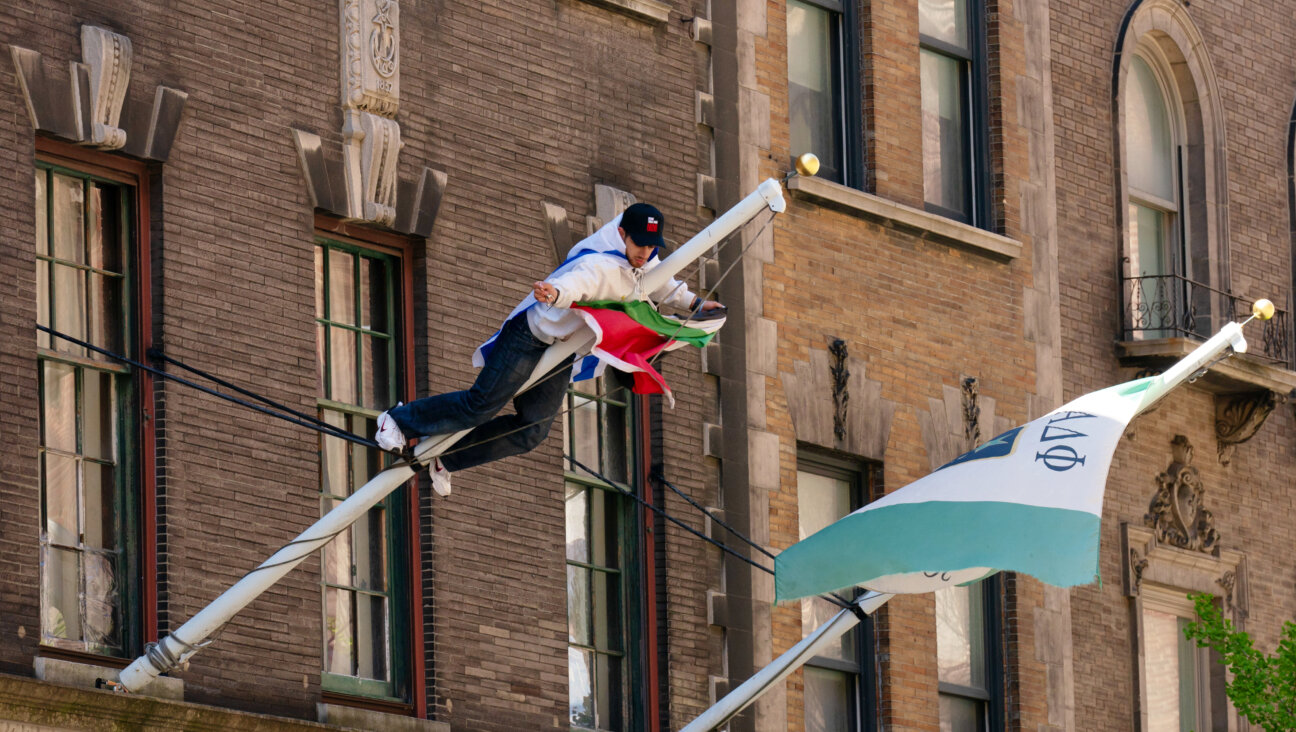Down to Their Gatkes: Israeli Dancers Bare Their Souls
Choreographer Ohad Naharin spawned a controversy at Israel’s 50th anniversary celebration in 1998. His troupe, Batsheva Dance Company, was to perform “Anaphaza,” which called for the dancers, clad in black suits and fedoras, to strip to their underwear, accompanied by the song from the Haggada, “Who Knows One?” Haim Miller, the deputy mayor of Jerusalem, and other Orthodox leaders complained, and Naharin was summoned before President Ezer Weizman, who tried to steer Naharin away from polemics. “He told me, ‘So let them wear gatkes,’” Naharin said, referring to long johns, according to press reports. Instead, Naharin resigned as artistic director of the company, Israel’s premiere modern dance troupe. In a show of solidarity, the dancers met backstage — while Vice President Al Gore was being seated in the auditorium — refused to be censored, and walked out.
This summer, American audiences can see what all the fuss was about. Naharin, who was eventually reinstated to his position, and his Batsheva Dance Company will have their New York premiere of “Anaphaza,” from July 23 through July 26 at the Lincoln Center Festival.
Naharin makes choreography that communicates on a visceral level to international audiences. Like most Naharin creations, this one reveals a brilliant formal structure. But it also possesses its share of anarchy and everything that is associated with that term: freedom, insanity, fear, pleasure, discomfort and belly laughs.
The name “Anaphaza” derives from the biological term anaphase, the stage in cell reproduction when chromosomes divide and move toward opposite poles. Naharin’s dance explores and jests with ideas surrounding the push and pull of bonding and separation. Rendered in the style of a choreographic collage, “Anaphaza” melds adagio duets and primal ensemble numbers together, managing to juggle images that are surreal, thought-provoking and entertaining. Dynamics play a vital role in “Anaphaza,” as demonstrated by the work’s diverse musical selections — from Avi Belleli to Aaron Copland to Arvo Pärt to percussion supplied by the dancers playing drums.
In fact, the pendulum swings of both visual and aural experiences propel Naharin’s creative engine. “By touching the extreme places, I can create a range from going as loud as you can to as quiet as you can,” said Naharin in an interview with the Forward. “In between you have a very big space. It’s about the overstatement and the understatement, and going between and the going in between is what interests me.”
Despite Naharin’s concern over the political turbulence in the Middle East, he remains unambiguous about the importance of Batsheva and his need to make art in Israel. “I don’t have an illusion that I can affect anything in terms of the politics of our country. If I want my voice to be heard, it’s through my work,” Naharin said. He also has praise for the support he has received from his homeland: “Israel, with everything that is going on, still succeeded in providing us with something very unique.”
The Batsheva Dance Company was founded in 1965 by Baroness Bethsabee (Batsheva) de Rothschild. Martha Graham, a close friend of the baroness, became the company’s first director, groomed its first generation of dancers, and even choreographed works exclusively for Batsheva.
In 1974, after serving in the Israeli army, Naharin was chosen by Graham to dance the role of Esau in her new ballet, “Jacob’s Dream.” He then joined Graham’s company in New York at her invitation and received further training at the Juilliard School. In 1980, he formed his own company in New York, the Ohad Naharin Dance Company. Naharin was appointed in 1990 as the artistic director of the Batsheva Dance Company, where his uniquely physical choreography and startling theatricality transfigured his gifted ensemble into a hot ticket.
As performed by the 25 dancers in “Anaphaza,” Naharin’s movement vocabulary seems to leave no tendons unstretched or muscles disengaged. Despite the intensity of the choreography, Naharin insists that its basis is therapeutic. “A lot of my movement language came about from the need to heal myself of a very serious back injury,” said Naharin, still athletic at age 50. “I became more efficient and free afterward than when I was well.”
Because of its non sequitur quality, “Anaphaza” sometimes prompts audiences to ask, “What does it mean?” Naharin hopes that people will just trust their instincts and intelligence. “I call it the power of imagination that allows us to enjoy being transformed. In this way, I am very dependent on the powers of imagination of my audience,” Naharin said. “All I can do is be coherent. I cannot give them eyes to see.”
Joseph Carman writes about dance for The New York Times.

I hope you appreciated this article. Before you go, I’d like to ask you to please support the Forward’s award-winning journalism this Passover.
In this age of misinformation, our work is needed like never before. We report on the news that matters most to American Jews, driven by truth, not ideology.
At a time when newsrooms are closing or cutting back, the Forward has removed its paywall. That means for the first time in our 126-year history, Forward journalism is free to everyone, everywhere. With an ongoing war, rising antisemitism, and a flood of disinformation that may affect the upcoming election, we believe that free and open access to Jewish journalism is imperative.
Readers like you make it all possible. Right now, we’re in the middle of our Passover Pledge Drive and we still need 300 people to step up and make a gift to sustain our trustworthy, independent journalism.
Make a gift of any size and become a Forward member today. You’ll support our mission to tell the American Jewish story fully and fairly.
— Rachel Fishman Feddersen, Publisher and CEO
Join our mission to tell the Jewish story fully and fairly.
Only 300 more gifts needed by April 30























